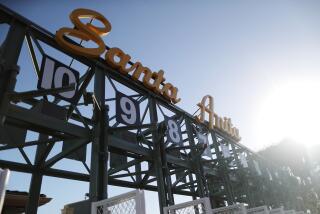They Fight for a King Every Day : Since 1965, thousands of pickup chess games have been won and lost on a 30-foot patch of ground near Santa Monica Pier. Participants range from grandmasters to the homeless.
- Share via
Joe Soto scanned the scene on the boardwalk at Seaside Avenue. “You’ve heard of Muscle Beach? Well this is Brain Beach.”
While their counterparts in Venice are pumping iron, the folks at the Santa Monica Chess Park are quietly engaged in the thinking person’s board game.
It is an unpretentious place, just six picnic tables in front of a large painted chessboard and makeshift signs that set the tone for play: “No alcohol, no disorderly conduct, violators reported!” But it draws curious looks from tourists, just as Muscle Beach does.
Thousands of pickup chess games have been won and lost on this 30-foot patch of ground since 1965.
More than 200 beginning-to-exceptional players make the rounds here on a good day. Weekend days are the most crowded. Sometimes participants will sit through 30 to 40 games, playing into the night by street lights with the glowing Ferris wheel in the background at the nearby pier.
Soto hasn’t played yet this morning; he’s waiting for an opening. He and other new arrivals watch the dozens of players as they savage each others’ pawns and repel invading knights.
All around them are surfers navigating waves, volleyball players digging for a shot, and in-line skaters ripping curves along the walkways, but these board game devotees remain engrossed in what could be called the most-overlooked beach sport.
The play attracts a diverse group, ranging in age from 16 to 80. You can find former U.S. Women’s Champion Greta Olsson there, as well as a retired Eastern Airlines worker; a Russian emigre physicist may be playing a homeless man.
Opponents may not speak the same language, but the game unites them.
“The worst beating I ever got out here,” recounted H. L. Walker, who is rated as a chess expert, “was from a guy who looked like he didn’t have two cents to rub together.” Walker is a systems programmer for Great Western Bank to support his chess passion.
Players not only swap knights and sacrifice pawns, they share chess lore. They study chess history as others do with U.S. history. They explain that the queen and the bishop had their power on the board greatly expanded in the 15th Century and the rook was once an elaborately carved piece that often included an elephant. They explain that it became a castle when Middle Ages manufacturers found it easier to turn out a cylindrical piece, and the set was not standardized until 1849.
Playing level ranges from novice to grandmaster, the highest level of play ranked by the U.S. Chess Federation. “We get experts, masters, international masters. We’ve even had Grandmaster James Tarjan play here,” said Mark Rosenberg, the unofficial king of the chess park.
For tournament play, it is necessary to be a member of the U.S. Chess Federation, the New York-based organization that ranks players for competition. The federation has 70,000 members, and many of the players in the park belong to the USCF. But the park welcomes amateurs for pickup games.
Rosenberg, an amateur player, is playing Jeff Heriot, 26, who became a Master at age 16. New victims line up waiting for a chance to play the sandy-haired young master, once he has finished off Rosenberg.
Next to them, Master Stephen Booth, 30, is engaged in a game. Booth is one of the top five African-American players, according to the chess federation.
“You could say I’ve learned it all at this park,” Booth allows between moves.
In the “lightning” chess game he’s playing, his fingers whip over the board as the final seconds run out on the chess clock. “I know,” his opponent suddenly concedes, “it’s checkmate.”
Rosenberg said one of the things he most appreciates about the park is that “it’s very diverse, cross-cultural,” which he said he thinks is especially important after the riots. “Race, creed, country of origin doesn’t matter here. We’re here for the game.”
Players are excited about the 1993 World Chess Championships, which will be held in Los Angeles for the first time. Grandmaster Garry Kasparov, who stripped Anatoly Karpov of the title in 1990, will vie for the $1.7-million prize.
But in the meantime, the Santa Monica Chess Park is rapidly becoming what Gold’s Gym is to bodybuilders.
“Chess is about making choices you have to live with,” concludes Joe Soto, whose patient wait for an open table has paid off. “It’s a perfect reflection of life.”
More to Read
Go beyond the scoreboard
Get the latest on L.A.'s teams in the daily Sports Report newsletter.
You may occasionally receive promotional content from the Los Angeles Times.










